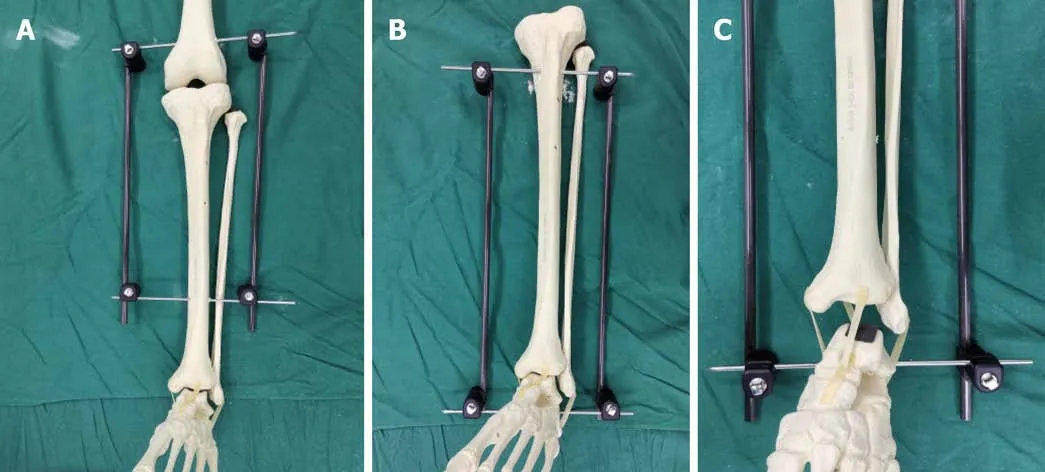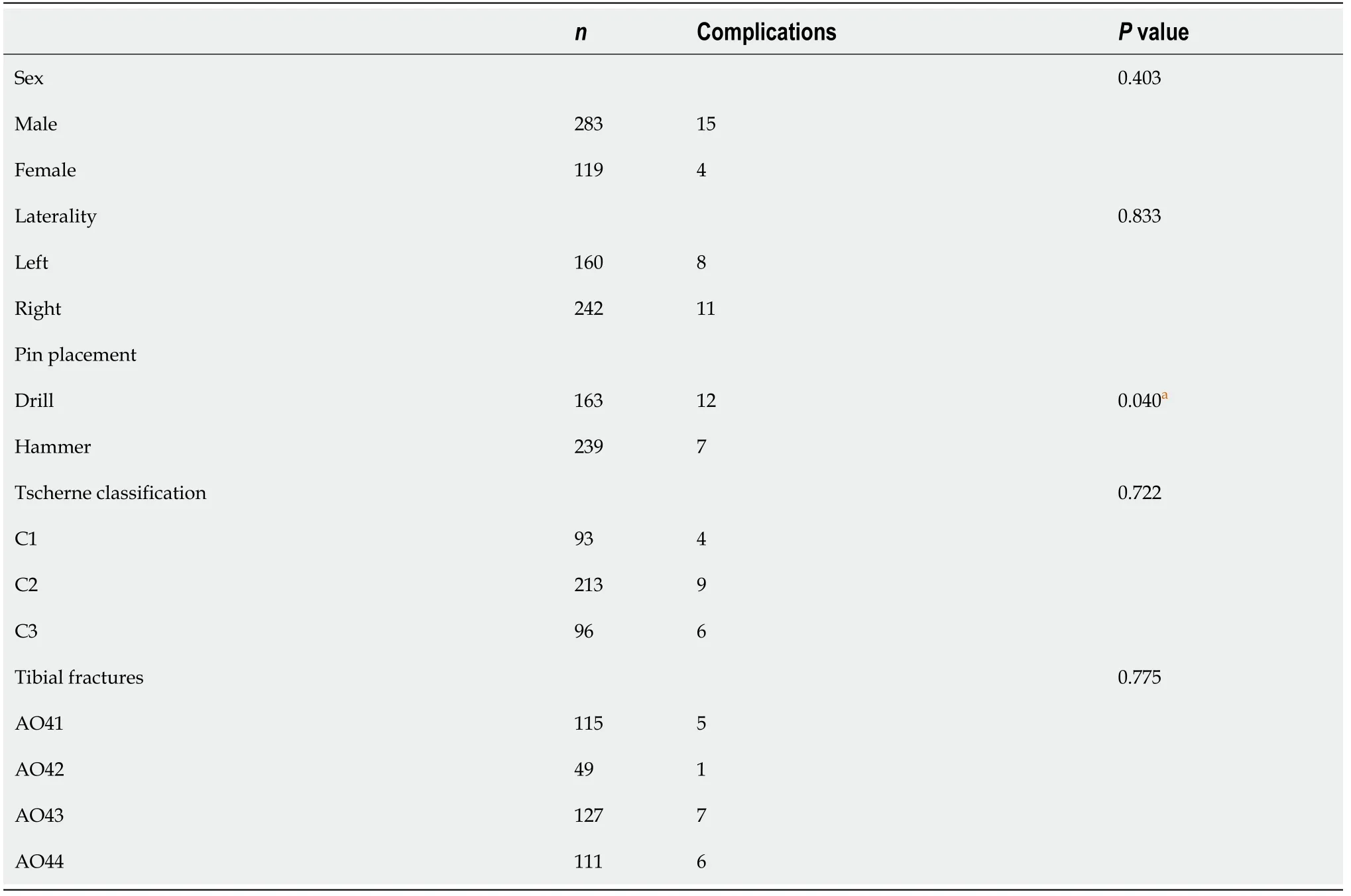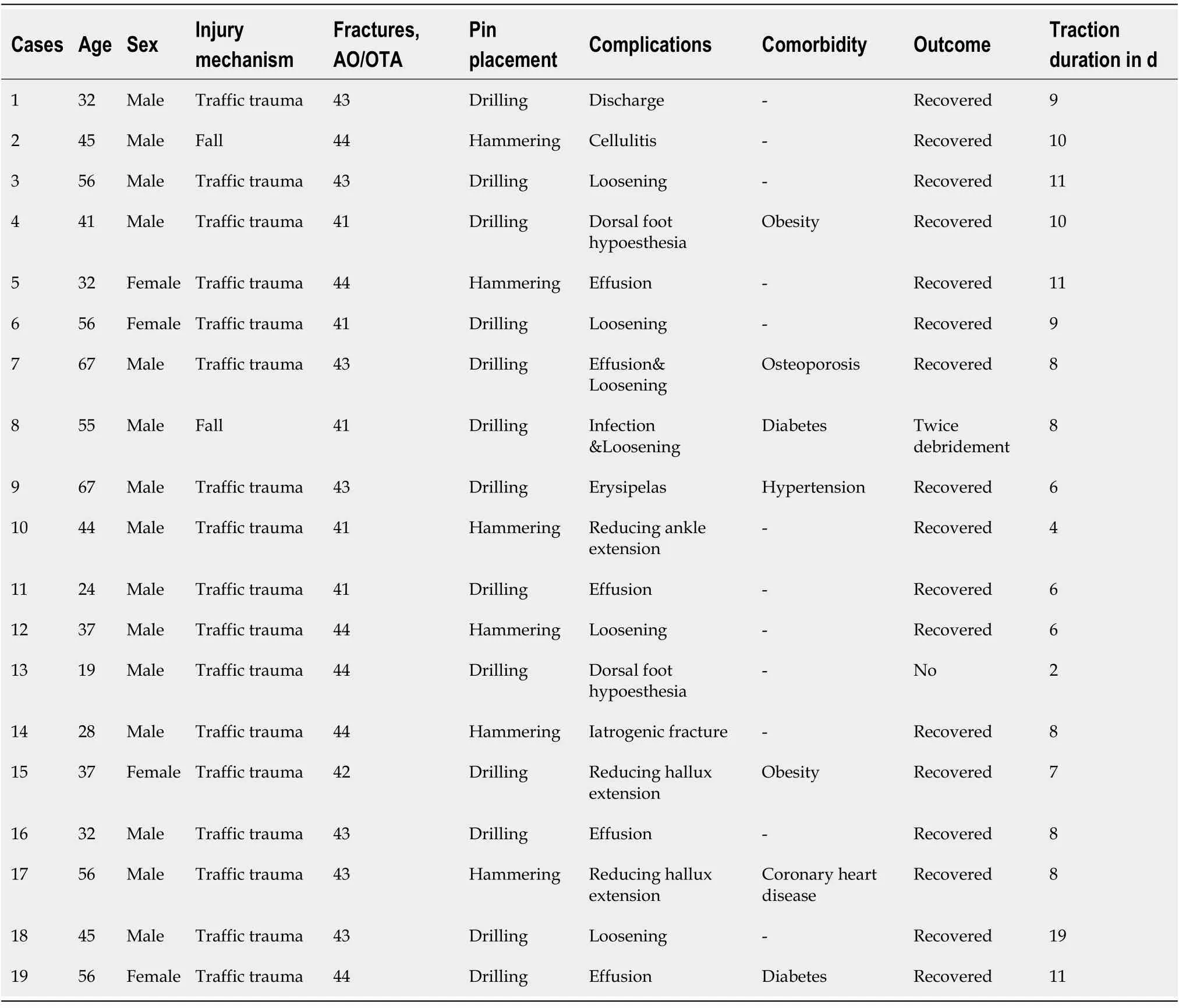Early complications of preoperative external traction fixation in the staged treatment of tibial fractures: A series of 402 cases
2020-04-08JiaZhaoYangWanBoZhuLiuBingLiQiRongDong
Jia-Zhao Yang, Wan-Bo Zhu, Liu-Bing Li, Qi-Rong Dong
Jia-Zhao Yang, Liu-Bing Li, Qi-Rong Dong, Department of Orthopedics, The Second Affiliated Hospital of Soochow University, Suzhou 215004, Jiangsu Province, China
Jia-Zhao Yang, Department of Traumatic Orthopedics, The First Affiliated Hospital of USTC,Hefei 230000, Anhui Province, China
Wan-Bo Zhu, Department of Traumatic Orthopedics, Affiliated Anhui Provincial Hospital of Anhui Medical University, Hefei 230000, Anhui Province, China
Abstract BACKGROUND Different external skeletal fixators have been widely used in preoperative traction of high-energy tibial fractures prior to a definitive surgical treatment. However,the early complications associated with this staged treatment for traction and soft tissue injury recovery have rarely been discussed.AIM To analyze the early complications associated with preoperative external traction fixation in the staged treatment of tibial fractures.METHODS A total of 402 patients with high-energy tibial fractures treated using preoperative external traction fixation at a Level 1 trauma center from 2014 to 2018 were enrolled in this retrospective study. Data regarding the demographic information,Tscherne soft tissue injury, fracture site, entry point placement, and duration of traction were recorded. Procedure-related complications such as movement and sensation disorder, vessel injury, discharge, infection, loosening, and iatrogenic fractures were analyzed.RESULTS The mean patient age was 42.5 (18-71) years, and the mean duration of traction was 7.5 (0-26) d. In total, 19 (4.7%) patients presented with procedure-related complications, including technique-associated complications in 6 patients and nursing-associated complications in 13. Differences in the incidence of complications with respect to sex, affected side, soft tissue injury classification,and fracture sites were not observed. However, the number of complications due to hammer insertion was significantly reduced than those due to drill insertions(2.9% vs 7.4%).CONCLUSION We found a low incidence of early complications related to the fixation.Furthermore, the complications were not significantly associated with the severity of the soft tissue injury and fracture site. Although relatively rough and more likely to cause pain, the number of complications associated with hammer insertion was significantly smaller than that of complications associated with drill insertion.
Key Words: Tibial fracture; External fixation; Bone traction; Complications; Vessels injury; Nerve injury
INTRODUCTION
High-energy tibial fractures (including AO/OTA-41/42/43/44), also known as “soft tissue injuries combined with fractures,” are considered a challenge for orthopedic traumatologists[1]. The soft tissue coverage and vascular distribution of the tibia are limited, leading to a high incidence of complications, such as wound dehiscence and infection[2]. Therefore, the condition of the soft tissue often limits the choice for open surgery for high-energy tibial fractures. The selection of a simple and universal preoperative transitional staged therapeutic strategy is particularly important for patients with high-energy tibial fractures who are not suitable for immediate internal fixation surgery.
Various external skeletal fixation procedures and devices have been widely used for preoperative traction of tibial fractures. As with all invasive procedures, the risks and complications associated with inserting pins, such as neurovascular injuries, are occasionally reported in literature[3-6]. However, systematic complication analyses are rarely reported as routine management in staged treatment for preoperative soft tissue amelioration of tibial fractures. In this study, we investigated the early complications associated with the application of preoperative external traction fixation in the staged treatment of high-energy tibial fractures, based on a series of 402 cases.
MATERIALS AND METHODS
This retrospective study was conducted at a Level 1 trauma center in a province with a population of more than 60 million in China. Patients who underwent staged treatment of closed tibial fractures and Gustilo I open fractures (AO/OTA-41 proximal tibial fractures, AO/OTA-42 middle tibial fractures, AO/OTA-43 distal tibial fractures or pilon fractures, and AO/OTA-44 ankle fractures) with preoperative external traction fixation between January 2015 to December 2018 were enrolled. The exclusion criteria were: Incomplete medical records, presence of a Gustilo II or III open fracture,previous disability, severe concomitant injury impairing verbal communication, and adoption of definitive treatment with an external fixator. A total of 402 patients were enrolled.
Demographic information, Tscherne soft tissue classification, fracture site, entry point placement, and duration of traction were recorded. Complications were assessed by physical examinations, as follows: Assessment of the range of motion, which included decreased flexion and extension of the ankle and toes; sensory examination,which included hypoesthesia or loss of sensation; vascular examination, which included decreased or absent pulse in the dorsalis pedis or posterior tibial arteries;signs of infection, which included discharge, redness, and swelling of the pin tract;loosening of the pin; and iatrogenic fractures. These physical examinations were performed at three different time-points (before traction, after traction, and after removal). Patients who showed inconsistent results before and after the placement of an external traction fixator were monitored for complications. Two observers collected the aforementioned data and the imaging data of the patients from the medical records. The ethics review committee of the institution approved the study protocol.
Intervention
The patient was positioned in the supine position. The limbs on the affected side were propped up using pillows. Based on the fracture site and length of the tibia, the length of the connecting rod was selected preoperatively to avoid a secondary incision. Bone landmarks were marked at both ends of the fracture to indicate the insertion points.After disinfection with 0.5% iodophor and draping, the injured limb was maintained in a neutral position by an assistant. We used 1% lidocaine to infiltrate and locally anesthetize the periosteum at the insertion points on both sides. A scalpel penetrated the skin, and two 4.0-mm smooth Steinmann pins were inserted at the proximal and distal ends of the fracture, parallel to the ground and perpendicular to the bone axis,using a hammer or an electric high-speed power drill. If necessary, the direction was adjusted with an assistant’s guidance before perforation of the first bone cortex.Table 1 shows the specific placement method. Femoral supracondylar and lower tibial pins were selected for tibial plateau fractures, while calcaneal and upper tibial pins were selected for tibial shaft fractures (Figure 1). Using the length of the healthy limb as a reference, the assistant pulled and tightened the distal pin-to-rod clamp when the length of the limb was restored or the length exceeded by approximately 1 cm. If necessary, the fracture alignment was reassessed using radiography to determine the need for further adjustments in traction force and transverse connecting rod length to achieve better stability. Correction of fracture shortening and maintenance of soft tissue tension were prioritized; anatomical reduction was not mandatory.
The operative area was disinfected again immediately after installation of the external traction fixator. Medical alcohol was used to disinfect the pin insertion site and connecting rod twice per day. Patients were discharged home and re-admitted for definitive surgical treatment. Follow-up was conducted through social networking or telephone interviews to assess the condition of the soft tissue. The standard for readmittance for definitive treatment depended on the recovery of the injured tissue was established at the discretion of the experienced surgeons.
Statistical analysis
SPSS Statistics 20 (IBM Corp, Armonk, NY, United States) was used for statistical analysis. For numerical variables, normality was tested using the Shapiro-Wilk test. As most variables displayed a skewed distribution, the Mann-WhitneyUtest was used for comparison. The chi-square test or Fisher’s exact test was used for the categorical variables. The tests were two-sided, andP< 0.05 was considered statistically significant. The incidence rate of complications was further analyzed with respect to the related factors including sex, affected side, screw placement method, and fracture site.
RESULTS
Illustrative cases
Case 1:A 55-year-old female patient was injured in a road accident (Figure 2) and experienced a left tibial plateau fracture (AO/OTA 41-C3) combined with a pulmonary injury. The Tscherne soft tissue injury classification was C3, and blisters were observed 12 h after the injury. The external traction fixator was applied in theward. The radiographs revealed an increased joint space and partial reduction of the lateral plateau. The blisters subsided on the 10thd after the injury, and a lateral-medial combined incision approach was used for internal fixation.

Table 1 Position and direction of Steinmann pin entry point

Figure 1 Illustration for external traction fixator. A: AO/OTA-41 with the femoral supracondylar and lower tibia entry point; B: AO/OTA-42/43/44 with the upper tibia and calcaneus entry point; C: Traction after fracture, restoring alignment and length through ligament tension.

Figure 2 Illustrative case 1. A: Radiograph after injury (AO/OTA-41-C3); B: Soft tissue swelling and blisters before external traction fixator installing; C: Ten days after external traction fixator application; D: Preoperative radiograph showed increased joint space and improved plateau alignment; E: Postoperative radiograph.
Case 2:A 43-year-old male patient injured his left leg in a fall, resulting in a closed tibial shaft fracture (AO/OTA 42-A1, 4F1A) with skin contusion (Figure 3). The Tscherne soft tissue injury classification was C2. The external traction fixator was applied after debridement in the emergency room. The radiograph showed satisfactory fracture alignment, and plate fixation was performed 8 d after the injury.
Case 3:A 41-year-old male patient, who had fallen from a height of 3 m, was diagnosed with a right pilon fracture (AO/OTA 43-C3) with a minor traumatic brain injury (Figure 4). The medial ankle skin showed contusion and stasis. The Tscherne soft tissue injury classification was C2. The external traction fixator was applied after debridement in the emergency room. A radiograph showed satisfactory alignment of the fracture fragments, and plate fixation was performed using the anterior externalposterior internal combined incision approach 8 d after the injury.

Figure 3 Illustrative case 2. A: Radiograph after injury (42-A1, 4F1A); B: Soft tissue swelling and skin contusion before external traction fixator installing; C:External traction fixator application. D: Preoperative radiograph showed a satisfactory fracture alignment.

Figure 4 Illustrative case 3. A: Radiograph after injury (AO/OTA 43-C3); B: Soft tissue swelling and skin contusion after external traction fixator application; C:Preoperative radiograph showed an improved fracture alignment; D: Postoperative radiograph showed a plate combined fixation.
Results
The demographic characteristics of the 402 patients are shown in Table 2. The mean age of the patients was 42.5 (18-71) years. Among these patients, 32.3% patients sustained injuries in car accidents; 10.7% patients, on falling from a height; 27.1%patients, in cycling accidents, 21.1% patients, during twisting motion, and 8.7%patients, in other accidents. Seventy-nine (19.7%) patients presented with concurrent comorbidities, as follows: 6.0% patients with brain trauma; 11.2% patients with chest injury; and 2.5% patients with abdominal injury. With the exception of two patients,external traction fixator was removed in all other patients 1 d before definitive surgery.The average duration of traction was 7.5 (3-26) d.
A total of 19 patients experienced related complications, including techniqueassociated complications in 6 patients and nursing-associated complications in 13 patients, leading to a total incidence of 4.7%. The details of complications of the cases are shown in Table 3. Differences were not observed with respect to sex, fracture side,soft tissue injury classification, and complications in different parts of the tibia.Complications associated with hammer insertion were significantly less frequently noted than those associated with drill insertion (2.9%vs7.4%). In 6 patients, the complications were technique related, accounting for 31.6% (6/19) of all complications,and complete recovery was noted in 83.3% (5/6) of these patients. Case 13 experienced a significant decrease in sensation in the dorsum after drilling into the proximal tibia;hence, it was pulled out immediately. The patient had not completely recovered sensation at the final follow-up. A young male patient (Case 14) experienced a crack fracture around the pin trajectory after hammering into the proximal end of the tibia.
Discharge and loosening were the most common complications, accounting for 38.5% (5/13) and 30.8% (4/13) of all complications, respectively. A male patient (Case 7) developed a pin trajectory infection, which spread along the plantar fascia on the 8thd after traction, owing to diabetes mellitus. Plantar necrotizing fasciitis wasconsidered. The patient underwent two procedures of debridement combined with placement of an antibiotic bone cement spacer and vacuum sealing drainage. He was finally cured on the 19thd. Vascular complications and compartment syndrome did not develop in this group.

Table 2 Demographic data
DISCUSSION
In this study, we assessed the complications associated with preoperative external traction fixation in the staged treatment of tibial fractures and found that the associated complication rate was low and was not significantly associated with the severity of soft tissue injury and fracture site. We did not observe a difference in the incidence of complications with respect to sex, affected side, soft tissue injury classification, and fracture site. However, the incidence of complications associated with hammer insertion was significantly lower than that of those associated with drill insertion.
Tibial plateau, shaft, pilon, and ankle fractures are commonly encountered in trauma centers. Most of these fractures are caused by high-energy injuries, such as falls and traffic accidents, and result in limb shortening or instability, accompanied by severe soft tissue injuries. Soft tissue injury is an important reference when determining the optimal timing of internal fixation surgery, and swelling is a direct indicator. Definitive surgery can be scheduled when soft tissue swelling has reduced,as indicated by the appearance of skin wrinkles and epithelialization of the blisters.Therefore, two-staged management, consisting of initial fracture stabilization followed by internal fixation, was performed for these high-energy tibial fractures. In a study on the staged treatment of pilon fractures, Zelleet al[7]reported that severe soft tissue injuries usually require a transitional stage of 1-4 wk. Cantonet al[8]reported that internal fixation can be attempted for tibial plateau fractures combined with soft tissue injuries 2-13 d after the injury[8]. Axial traction at the fracture site aids in recovering the limb length and alignment while reducing pain and providing favorable conditions for the elimination of swelling[9]. Accordingly, in our study, the mean time to reduceswelling before the surgery was 7.5 d.

Table 3 Complications details
The transfixion pin traction system was first used for stabilization before intramedullary nailing of the tibia, a procedure initially described as “traveling traction”[10]. Later, it was improved and simplified by many researchers, and has been widely used as a minimally invasive auxiliary reduction technique in surgery[11-13].Inspired by the “traveling traction”[14], the insertion point in this technique is the common bone traction point for lower limb fractures, such as that in femoral supracondylar, tibial tubercle, and calcaneal traction. Previous reports have described the selection of the entry points and safety zones in detail[9,15-17]. We believe that palpation and accurate marking of the insertion points are important steps for reducing the incidence of complications. However, patient anatomy and surgical techniques vary. The irregular triangular structure of the proximal tibia, for example,may lead to the development of iatrogenic fractures owing to slippage of the traction pin and failure to pass through the two cortexes (Case 14). In addition, obesity can directly affect the palpation of the bony marks at the point of entry. A Steinmann pin is required to access the bone through the soft tissue, which may cause damage to the nerves, blood vessels, and tendons (Cases 4 and 15).
Linnet al[3]reported a popliteal artery pseudoaneurysm caused by proximal tibial traction. However, injury to the major vessels can be avoided as long as the insertion site is not located excessively posteriorly to the proximal tibia during the operation[17].Vascular injury was not noted in our study. Sobolet al[9]reported that transfixion pin injuries are usually resolved after pin removal. This is in accordance with our study,where 83.3% (5/6) of the patients with transfixion pin injuries recovered completely.We believe that in the future, high-risk patients, such as those with obesity, may warrant B-mode ultrasound-guided pin placement to reduce the development of complications, similar to the method used by Yuet al[18]for the reduction of femoral neck fractures.
Denham pins are better anchored in the bone but cause more damage to the soft tissue than smooth pins during placement[19]. In our study, soft tissue injury caused by high-speed power drilling was more frequently noted than hammer injury; resolution of the associated complication was difficult. The heat generated during drilling may have caused soft tissue and bone damage[20]. However, pain may be experienced when the hammer method is used, despite the administration of local anesthesia. In our center, hammers were used for pin insertion during 2015 and 2016; therefore, this approach was abandoned and replaced by drilling. Although an association between the type of pin site dressing and development of deep infection was not reported in a recent study, nursing care was described as an important factor in pin site infection[21].In this regard, smooth Steinmann pins are advantageous in that they facilitate discharge. Common pin site infections or erysipelas and swelling can be controlled well with frequent dressing changes and antibiotic treatment. Moreover, an incision wound that is too small for pin insertion may lead to poor drainage, which should be considered when inserting the pin. Special caution must be exercised when the procedure is performed for patients with diabetes owing to the increased risk of adverse outcomes.
Regardless of the traction type, a certain force must be applied to the soft tissue and ligaments to achieve fracture alignment. Excessive traction can lead to vascular and nerve damage. In this regard, the most serious outcome in tibial fractures is the development of compartment syndrome. Shakespeareet al[22]reported that every additional 1 kg of traction weight would result in a 5.7% increase in the posterior deep fascial pressure and a 1.6% increase in the anterior fascial pressure. To prevent excessive tension, in our study, the length of the healthy limb was used as a reference during traction, and the distal pin was pulled 1 cm beyond the healthy limb. This value can be marked on the connecting rod in advance, and can be adjusted depending on the radiographic assessment, if necessary.
Although some researchers reported a certain correlation between the Tscherne soft tissue injury classification and postoperative complications[23], our results indicated that the severity of soft tissue injury was not associated with pin insertion complications. It is worth noting that, in all our patients, the pin was placed far from the site of injury. The stabilizing effect of external traction fixation may be more important than that of conventional bone traction for combined ligament injuries. This is different from bone traction alone, which is contraindicated in ligament injuries. The pin insertion and postoperative complications, especially postoperative infection, are important concerns among orthopedic surgeons. The first stage treatment was usually maintained for 14 or 28 d[24]. Beyond this period, the risk of infection may need to be reassessed or an external fixator may be used as the final treatment. It is recommended that the time interval between stage 1 and stage 2 should not be more than 9 or 14 d[25,26]. Evaluating the timing and interval of staged treatment requires a combination of individual patients and dynamically observed indicators of infection.
The limitations of this study included the lack of objective evaluation indicators,such as electromyography to evaluate the sensory and motor parameters.Furthermore, the clinical significance of some complications, such as injury of the medial superior knee artery branch caused by supracondylar traction, was not assessed. In addition, the analysis of the association between temporary fixation and definitive care complications was limited due to the lack of a control group. The results of this study must be validated in a prospective comparative study.
CONCLUSION
Staged treatment of tibial fractures is suitable for soft tissue injury and is not indicated for immediate internal fixation. External traction fixation for staged treatment is a simple procedure which involves fewer components that allow for quick installation.In this cases series, we found that the incidence of early complications was low, and that the technique could be safely performed by a junior resident. As a “travelling traction,” external traction fixation for staged treatment may also play an important role in the prevention of deep venous thrombosis of the lower extremities and chest complications. We believe that external traction fixation is a viable alternative for the staged treatment of tibial fractures.
ARTICLE HIGHLIGHTS
Research background
External traction fixation for staged treatment is a simple procedure which involves fewer components that allow for quick installation.
Research motivation
The safety of external traction fixation has not been well studied.
Research objectives
Analyze the early complications associated with preoperative external traction fixation in the staged treatment of tibial fractures.
Research methods
This study included 402 patients who underwent external traction fixation for highenergy tibial fractures.
Research results
Overall incidence of complications was low (4.7%); vascular injury or compartmental syndrome was not noted.
Research conclusions
Complications of hammer insertions were significantly fewer than drill insertions.
Research perspectives
We found a low incidence of early complications related to the fixation.
杂志排行
World Journal of Clinical Cases的其它文章
- Relationship between non-alcoholic fatty liver disease and coronary heart disease
- Remission of hepatotoxicity in chronic pulmonary aspergillosis patients after lowering trough concentration of voriconazole
- Endoscopic submucosal dissection as alternative to surgery for complicated gastric heterotopic pancreas
- Observation of the effects of three methods for reducing perineal swelling in children with developmental hip dislocation
- Predictive value of serum cystatin C for risk of mortality in severe and critically ill patients with COVID-19
- Sleep quality of patients with postoperative glioma at home
